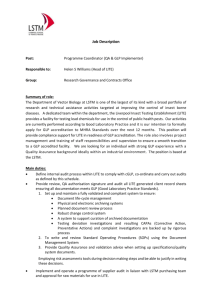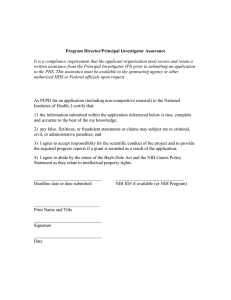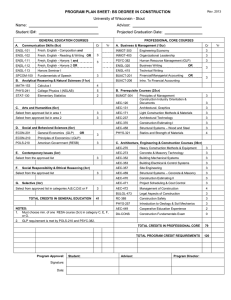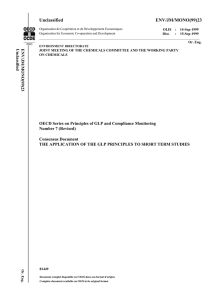Testing Facility Management for GLP Testing
advertisement
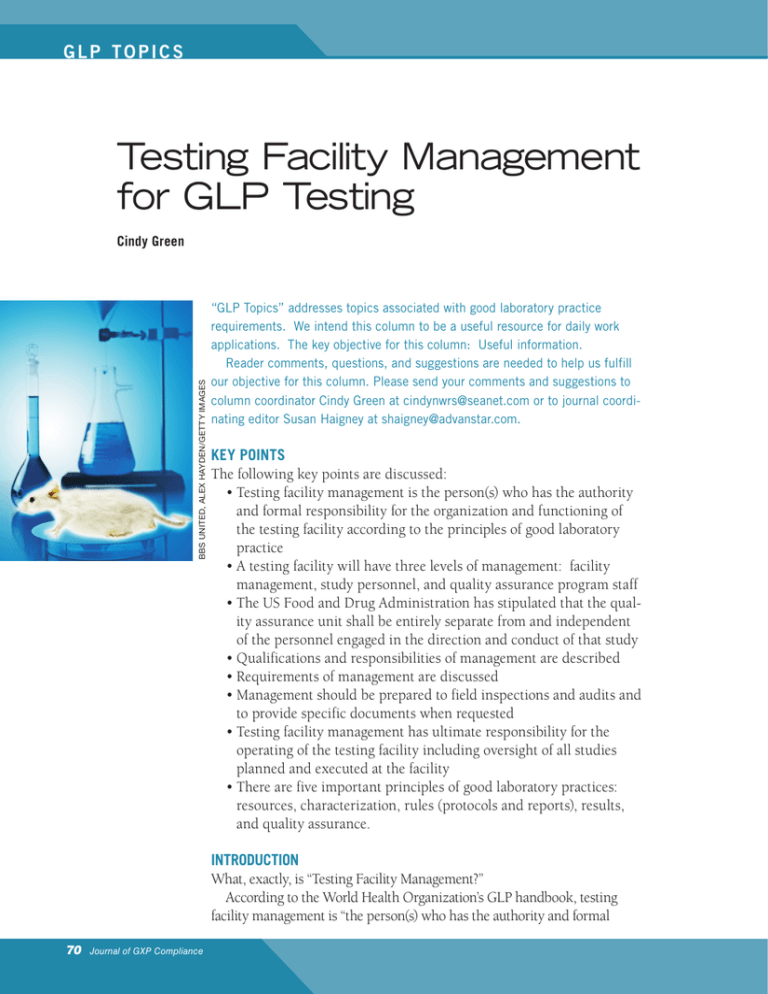
GLP TOPICS Testing Facility Management for GLP Testing BBS UNITED, ALEX HAYDEN/GETTY IMAGES Cindy Green “GLP Topics” addresses topics associated with good laboratory practice requirements. We intend this column to be a useful resource for daily work applications. The key objective for this column: Useful information. Reader comments, questions, and suggestions are needed to help us fulfill our objective for this column. Please send your comments and suggestions to column coordinator Cindy Green at cindynwrs@seanet.com or to journal coordinating editor Susan Haigney at shaigney@advanstar.com. KEY POINTS The following key points are discussed: •Testing facility management is the person(s) who has the authority and formal responsibility for the organization and functioning of the testing facility according to the principles of good laboratory practice •A testing facility will have three levels of management: facility management, study personnel, and quality assurance program staff •The US Food and Drug Administration has stipulated that the quality assurance unit shall be entirely separate from and independent of the personnel engaged in the direction and conduct of that study •Qualifications and responsibilities of management are described •Requirements of management are discussed •Management should be prepared to field inspections and audits and to provide specific documents when requested •Testing facility management has ultimate responsibility for the operating of the testing facility including oversight of all studies planned and executed at the facility •There are five important principles of good laboratory practices: resources, characterization, rules (protocols and reports), results, and quality assurance. INTRODUCTION What, exactly, is “Testing Facility Management?” According to the World Health Organization’s GLP handbook, testing facility management is “the person(s) who has the authority and formal 70 Journal of GXP Compliance Cindy Green responsibility for the organization and functioning of the test facility according to the principles of good laboratory practice” (1). Management of a testing facility may involve more than one person in more than one location. The particular management level to whom a study director reports has the ultimate responsibility for ensuring that the facilities operate in compliance with the principles of good laboratory practice (GLP). But even in the simplest case, a testing facility will have three levels of management. These include facility management, study personnel, and quality assurance program staff. In any endeavor with multiple levels of management, it is absolutely critical that clear lines of authority and communication are established and that responsibilities are assigned. It is the responsibility of the testing facility management to ensure that clear lines of communication exist and that these lines of communication are clearly documented. MANAGEMENT QUALIFICATIONS AND RESPONSIBILITIES Before delving into who the management person(s) can be and what that person’s responsibilities are, perhaps a quick discussion of who that person cannot be is in order. A question often asked is whether the study director can also hold a management position in the testing facility. The US Food and Drug Administration has stipulated in 21 CFR, Part 58, Subpart B, Section 58.35 that “For any given study, the quality assurance unit shall be entirely separate from and independent of the personnel engaged in the direction and conduct of that study” (2). Based on this regulation, FDA has answered the question with a resounding “No.” It may be inferred from this that for study personnel, such as the study director, to also have a management role would violate the “entirely separate from and independent of” requirement because management does oversee the quality assurance unit (2). Qualifications So who can qualify as testing facility management? According to 21 CFR, Part 58, Subpart B, Section 58.29, “Each individual…responsible for the super- vision of a nonclinical laboratory study shall have education, training, and experience, or combination thereof, to enable that individual to perform the assigned functions”(2). Of course, from the discussion above we could add that they must not be involved in the actual conduct of the study itself. Responsibilities and Requirements What are the responsibilities of the testing facility management? Overall, management has the responsibility for the organization of the testing facility. Although testing facility management is permitted to delegate designated control activities through the organization, management is required to always maintain overall responsibility. Beyond the organizational responsibility, however, probably first and foremost is that management is ultimately responsible for ensuring that the facility as a whole operates in compliance with the principles of good laboratory practice. At a minimum, management should ensure that their facility is compliant with the GLP principles described as follows. Organizational chart. A statement should exist, such as an organizational chart, that identifies the individual(s) within the testing facility who fulfill the responsibilities of management. It should be noted that often the first document requested by national monitoring authorities is the organizational chart. It is this document that describes how the facility functions. Master plan. A sufficient number of qualified personnel, appropriate facilities, equipment, and materials should be available for the timely and proper conduct of the study. The planning and resource allocation system required by GLP is generally referred to as a master plan or master schedule. According to the WHO GLP handbook, the master plan or schedule, no matter what form it takes, must ensure that all studies, contracted or in-house, are included. It must ensure that change control reflects changes in dates and workload, and that activities such as protocol review and report preparation are allocated sufficient time. FurtherWinter 2011 Volume 15 Number 1 71 GLP TOPICS more, the system must be the “official” one (no competing systems for the same purpose), and it must be described in an approved standard operating procedure (SOP). Personnel records. A record of the qualifications, training, experience, and job description for each professional and technical individual should be maintained. Personnel function. Personnel should clearly understand the functions they are to perform and, where necessary, be provided training for these functions. Procedures. Appropriate and technically valid SOPs should be established and followed, and all original and revised SOPs should be approved. Quality assurance. A quality assurance program with designated and adequately trained personnel should be established. The quality assurance responsibility should be performed in compliance to the principles of good laboratory practice. Study director. A study director with the appropriate qualifications, training, and experience should be designated for each study before the study is initiated. A study director should be replaced, if necessary, according to established procedures and should be properly documented. Principal investigator. For a multi-site study, a principal investigator should be designated. The principal investigator should be appropriately trained, qualified, and experienced to supervise the delegated phase(s) of the study. A principal investigator should be replaced, if necessary, according to established procedures and should be properly documented. Study plan. The study director has approved the study plan and has made the approved study plan available to the quality assurance personnel. SOP historical file. A historical file of all SOPs should be maintained. Archives. An individual should be designated who is responsible for the management of the archive(s). Master plan maintenance. The master plan or schedule should be properly maintained. 72 Journal of GXP Compliance Supplies. The testing facility supplies should meet the requirements appropriate to their use in a study. Communication. For a multi-site study, clear lines of communication should exist between the study director, principal investigator, the quality assurance program(s), and study personnel. Characterization of test and reference items. Test and reference items should be appropriately characterized. Computerized systems. Procedures should be in place to ensure that computerized systems are suitable for their intended purpose and are validated, operated, and maintained in accordance with the principles of good laboratory practice (2). AUDIT READINESS In addition to the overall compliance with the principles of good laboratory practice (2), management should be prepared to field inspections and audits and to provide specific documents when requested. According to the WHO GLP handbook (1), testing facility management should be prepared to produce the following documents for inspection: •Floor plans •Facility management and scientific organization charts •C Vs of personnel involved in a study •List(s) of ongoing and completed studies with information on the type of study, initiation and completion dates, test system, method of application of test substance, and name of the study director •Staff health surveillance policies •Staff job descriptions and staff training programs and records •A n index to the facility’s SOPs •Specific SOPs as related to the studies or procedures being inspected or audited •List of the study directors and sponsors associated with the study being audited. TESTING FACILITY OPERATIONS Testing facility management has ultimate responsibility for the operating of the testing facility. This includes the oversight of all studies planned and Cindy Green executed at the testing facility. If the testing conducted at the testing facility is under contract (i.e., external companies, organizations, facilities request contract services from the testing facility), the testing facility is still responsible for assuring that the test articles and controls have been properly characterized and the characterization is documented. This does not necessarily mean that the testing facility management is responsible for reviewing and determining the adequacy of the characterization of test and control articles; however, it does mean that testing facility management must ensure there is a system in place to assure that those knowledgeable in the review of the test and control article characterization have satisfactorily completed the review. In addition, it is the responsibility of testing facility management to ensure that the test and control articles have been approved for use in the planned GLP studies. This process of assurance that the test and control articles have been approved must be documented, and the records of the review and approval must be included in the study files. sonnel, careful preparation and review of protocols and testing procedures, validation or verification of test methods, qualification of materials, qualification of testing laboratories, handling and care of animals (i.e., test systems), validation of software, statistical techniques for sampling and data analysis, monitoring of studies by the quality assurance unit, and much more. The oversight and control of all aspects of GLP studies conducted by the testing facility are the responsibility of testing facility management. SUMMARY In summary, there are five important principles of good laboratory practices. These are resources, characterization, rules (i.e., protocols and reports), results, and quality assurance (3). Testing facility management has a significant responsibility in the management of studies conducted in or by the testing facility. Adequate controls must be in place to assure the data integrity, which is absolutely vital to the usability of GLP studies to support product safety. To assure data integrity, there are many controls required including equipment calibration and maintenance, training of study per- FDA GLP SOP WHO REFERENCES 1. WHO, Handbook–Good Laboratory Practice (GLP), UNDP/World Bank/WHO. 2. FDA, 21 CFR Part 58, Good Laboratory Practices, Title 21— Food And Drugs Chapter I—Food And Drug Administration, Department Of Health And Human Services, Subchapter A— General, PART 58 Good Laboratory Practice for Nonclinical Laboratory Studies, 43 Federal Register 60013, Dec. 22, 1978. 3. WHO, Good Laboratory Practice (GLP) – Training Manual, 2nd Edition, WHO, 2008. GXP ARTICLE ACRONYM LISTING US Food and Drug Administration Good Laboratory Practice Standard Operating Procedure World Health Organization ABOUT THE AUTHOR Cindy Green, RAC, has been working with regulated industry for nearly 35 years holding senior positions in regulatory, quality assurance, and quality control for several biotechnology and medical device companies. She has been president of her own consulting company for the past 18 years. Cindy can be reached by e-mail at cindynwrs@seanet.com. Winter 2011 Volume 15 Number 1 73
